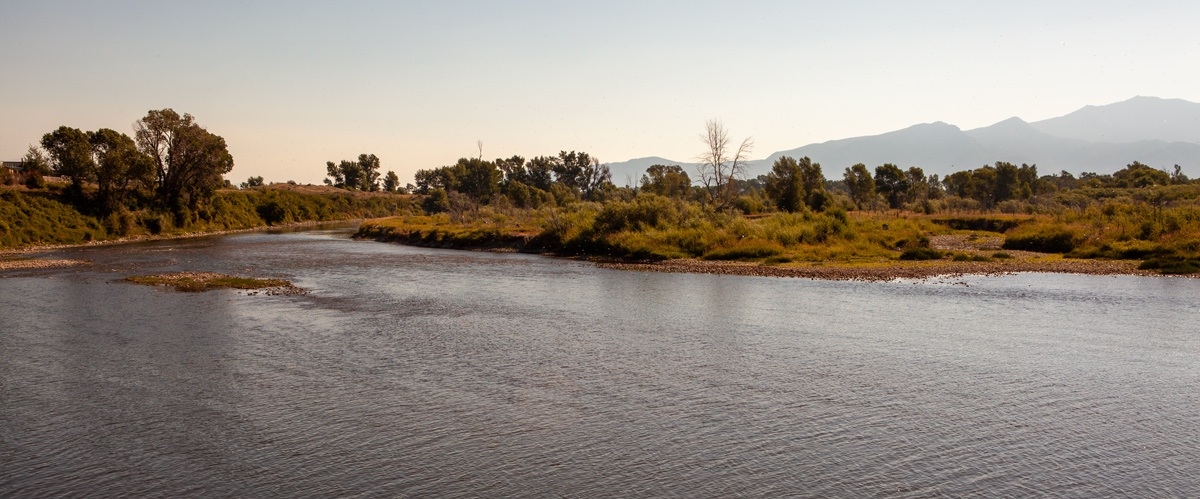Jefferson River Valley, MT Lewis’s scouting detachment departs before sunrise, breakfasts at midday, and scouts until nightfall. The trees ahead indicate that the already shallow Jefferson River soon forks. Several miles behind Lewis, the main party tows and walks the canoes up the cold river.
An Indian Footprint[1]Originally aired weekdays by Yellowstone Public Radio during the Bicentennial observance of 2003-2006. Narrated by Hal Hansen. Scripts by Whit Hansen and Ed Jacobson. Produced by Leni Holliman. © … Continue reading
Lewis: Nearing the Forks
Jefferson River Gravel Bar
Jefferson River near Silverstar, Montana, 22 July 2013. © by Kristopher K. Townsend. Permission to use granted under the Creative Commons Attribution-Share Alike 4.0 International license.
Lewis’s Long Day
Set out early this morning, or before sunrise; still continued our march through the level valley on the lard. side of the river . . . . at 11 A. M. Drewyer killed a doe and we halted about 2 hours and breakfasted, and then continued our rout untill night without halting
—Meriwether Lewis
Mysterious Holes
this evening we passed through a high plain for about 8 miles covered with prickley pears and bearded grass, tho’ we found this even better walking than the wide bottoms of the river, which we passed in the evening; these altho’ apparently level, from some cause which I know not, were formed into meriads of deep holes as if rooted up by hogs these the grass covered so thick that it was impossible to walk without the risk of falling down at every step.
—Meriwether Lewis
Jefferson River Valley Fauna
we saw many deer, Antelopes [pronghorns] ducks, gees, some beaver and great appearance of their work. also a small bird and the Curlooe as usual . . . . The fish of this part of the river are trout and a species of scale fish of a while [white] colour and a remarkable small long mouth which one of our men inform us are the same with the species called in the Eastern states bottlenose.
—Meriwether Lewis
Clark: Walking the Canoes
Shallow Jefferson River
we are oblige to haul over the Canoes Sholey in maney places where the Islands are noumerous and bottom Sholey, in the evening the river more rapid and Sholey we encamped on an Island avove a part of the river which passed thro a rockey bed enclosed on both sides with thick willow current & red buries &c &c
—William Clark
Beaver Springs
passed a verry large Spring on L. S. which makes from under the mountains. the beaver has damed up the mouth & built lodges all through the pond it forms. it falls over the beaver dam in to the River verry Steep, about 4 feet.—
—Joseph Whitehouse
Weather Diary
State of the Thermometer at rise
Weather at rise
Wind at rise
State of the Thermometer at 4 P.M. Weather at 4 P.M. Wind at 4 P.M. State of the River 50 [above 0] fair N. E. 86 [above 0] fair N. E. fallen ½ in. —Meriwether Lewis[2]To assist the reader, the editor of this web page has omitted the date column, merged the “State of the river” columns, and spelled out some abbreviations.
The Specimen Shipment
New-Orleans August 3rd. 1805.
Dear Sir [Thomas Jefferson],
The Articles sent you by Captain Lewis, left this City some Days ago; and were put on board the Ship Comet; they were addressed to the Care of the Collector at Baltimore; and he was requested to forward them by Land to the City of Washington.
The Skins were carefully repacked, and the necessary measures taken to preserve them. The little Animal [prairie dog] and the Birds were all well, and I sincerely hope may reach you in safety. By Captain Carmick of the Marine Corps, who sailed two Days since, from this Port for Washington, I forwarded you, a Mandine [Mandan] Pot, being the only species of Culinary Instruments used by the Mandine Indians; It Came in a Boat, from the Illinois, and is supposed to have been transmitted by Captain Lewis.
I have the honor to be Sir, With great respect, Your faithful friend
William C. C. Claiborne[3]Founders Online, National Archives, founders.archives.gov/documents/Jefferson/99-01-02-2176 [Originally from The Papers of Thomas Jefferson ]; also in Letters of the Lewis and Clark Expedition with … Continue reading
Notes
| ↑1 | Originally aired weekdays by Yellowstone Public Radio during the Bicentennial observance of 2003-2006. Narrated by Hal Hansen. Scripts by Whit Hansen and Ed Jacobson. Produced by Leni Holliman. © 2003 by Yellowstone Public Radio. |
|---|---|
| ↑2 | To assist the reader, the editor of this web page has omitted the date column, merged the “State of the river” columns, and spelled out some abbreviations. |
| ↑3 | Founders Online, National Archives, founders.archives.gov/documents/Jefferson/99-01-02-2176 [Originally from The Papers of Thomas Jefferson ]; also in Letters of the Lewis and Clark Expedition with Related Documents: 1783–1854, 2nd ed., ed. Donald Jackson (Urbana: University of Illinois Press, 1978), 253. |

